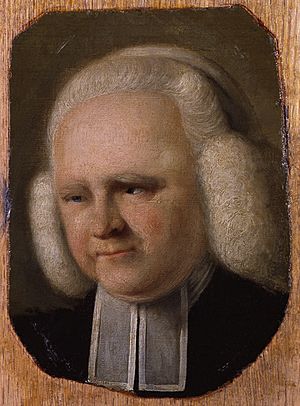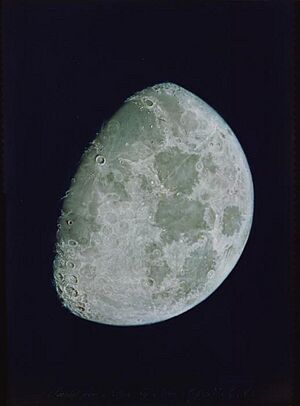John Russell (English painter) facts for kids
John Russell (born March 29, 1745 – died April 20, 1806) was a famous English painter. He was known for his amazing portraits, which he created using both oil paints and pastels. He also wrote books and taught others how to paint.
Contents
Life as an Artist
John Russell was born in Guildford, Surrey. His father, John Russell Senior, was a bookseller and print seller, and even served as mayor of Guildford four times! His father was also an artist and drew pictures of the town. John Russell went to the Royal Grammar School, Guildford. He quickly showed a strong talent for art.
He learned to paint from Francis Cotes, who was a pioneer in English pastel painting. Like Cotes, Russell admired the pastel drawings of Rosalba Carriera. Her methods helped him create his own unique "sweetening" technique.
When he was 19, John Russell became a Methodist. This caused some disagreements with his family and teacher. He was very open about his strong religious beliefs and often tried to share them with others.
Starting His Own Studio
In 1767, Russell opened his own studio in London. He met Dr. William Dodd and painted his portrait in 1768. He was also introduced to Selina, Countess of Huntingdon. She tried to convince him to stop painting and join her Methodist training college, but he didn't.
On February 5, 1770, he married Hannah Faden. She was the daughter of a print and map seller from Charing Cross. They lived at No. 7 Mortimer Street in Cavendish Square.
Russell's work often required him to travel all over Britain. In 1772, he wrote a book called Elements of Painting with Crayons. Before this, he had already won awards for his drawings from the Society of Arts in 1759 and 1760. In 1770, he joined the Royal Academy art school and won a gold medal for his figure drawing that same year. He showed his artwork at the Society of Artists of Great Britain in 1768. He also displayed 330 works at the Royal Academy between 1769 and his death.
In 1770, Russell painted the Methodist minister George Whitefield and William Wilberforce, who was only eleven years old at the time and later became a famous helper of others. In 1771, he showed an oil portrait of Charles Wesley at the Royal Academy. In 1772, he painted Selina, Countess of Huntingdon in pastel. This painting was lost at sea, but it was later engraved. He also painted her in oils. In the same year, he became an associate of the Royal Academy. The next year, 1773, he painted John Wesley.
Royal Recognition
In 1788, after a long wait, Russell was elected a Royal Academician. This meant he was a full member of the Royal Academy. In the same year, he painted a portrait of the famous naturalist Sir Joseph Banks. In 1789, he was asked to paint the royal doctor Francis Willis. The King was very pleased with the painting.
In 1790, John Russell was given a special title: Crayon (Pastel) Painter to King George III, Queen Charlotte, the Prince of Wales, and the Duke of York. Russell painted all of these royal family members. With such important royal support, he became very popular and had many wealthy clients.
John Russell had very strong religious beliefs and was a devoted follower of George Whitefield. He kept a detailed diary from 1766 until he died. In his diary, he wrote about his thoughts, his religious practices, and sometimes about the people he painted. He would not work on Sundays and didn't allow anyone into his painting room on that day. He was even careful about going out to dinner because he worried about hearing bad language. He was friends with Sir Joshua Reynolds and dined with him at the Royal Academy and other clubs. However, he always left these events early.
He was often sick throughout his life. In 1803, he became almost deaf after getting cholera. He died in Hull in 1806 after getting typhus.
You can see John Russell's artwork in many galleries in the UK and around the world. The largest collection is at Guildford House Art Gallery in Guildford. Many of his portraits were copied as engravings by artists like Joseph Collyer, Charles Turner, and James Heath.
Interest in Astronomy
Russell was also very interested in astronomy. With help from his daughter, he created a map of the Moon. He engraved this map onto two plates, which formed a globe showing the part of the Moon we can see. This project took him twenty years to finish!
He also invented a device to show how the Moon appears, which he called "Selenographia." Russell's large and very detailed pastel drawing called The Face of the Moon (1793–1797) is considered one of the most accurate early pictures of the Moon. Some of his best portraits were of famous scientists of his time, like his friend William Herschel. Russell painted Herschel holding a star chart that showed his discovery of Uranus. Herschel provided the powerful telescope that Russell used to carefully observe the Moon.
His Family
John Russell had twelve children, though four of them died when they were very young. His son, William Russell (1780–1870), also showed portraits at the Royal Academy from 1805 to 1809. The National Portrait Gallery has a portrait of Judge Sir John Bailey painted by William. In 1809, William became a priest and stopped painting. He was the rector of Shepperton, Middlesex, for forty years and died on September 14, 1870. Two of John's daughters, Anne and Jane, also became artists.




